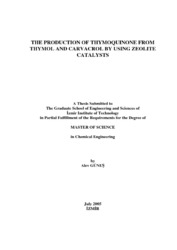Please use this identifier to cite or link to this item:
https://hdl.handle.net/11147/3314Full metadata record
| DC Field | Value | Language |
|---|---|---|
| dc.contributor.advisor | Bayraktar, Oğuz | - |
| dc.contributor.author | Güneş, Alev | - |
| dc.date.accessioned | 2014-07-22T13:51:18Z | - |
| dc.date.available | 2014-07-22T13:51:18Z | - |
| dc.date.issued | 2005 | - |
| dc.identifier.uri | http://hdl.handle.net/11147/3314 | - |
| dc.description | Thesis(Master)--Izmir Institute of Technology, Chemical Engineering, Izmir, 2005 | en_US |
| dc.description | Includes bibliographical references (pages: 68-73) | en_US |
| dc.description | Text in English; Abstract: Turkish and English | en_US |
| dc.description | xi,73 leaves | en_US |
| dc.description.abstract | In this thesis study, by using general flexible ligand method, Cr(III), Fe(III),Bi(III), Ni(II) and Zn(II) complexes of N,Nbis(salicylidene)propane-1,3-diamine (H2salpn) encapsulated in NaY-zeolite were prepared. All catalyst were characterized by Fourier transform infrared (FT-IR), X-ray diffraction (XRD) and Scanning electron microscopy (SEM) analyses to confirm the complex encapsulation. Activities of all prepared catalysts for the decomposition of hydrogen peroxide and oxidation of carvacrol were tested. Leaching test or heterogeneity test was also performed. The performances of all catalysts were compared based on the leaching test results and carvacrol conversion. Thymohydroquinone and benzoquinones were observed as by-products at high conversions of carvacrol. No product was formed in the absence of a catalyst. Fe(salpn)-NaY catalyst has shown the highest carvacrol conversion of 27.6% with a yield of 22.0% which was followed by Cr(salpn)-NaY catalyst with 23.5% carvacrol conversion with a yield of 17.6%. Other catalysts have shown relatively lower performances in terms of carvacrol conversion and leaching. The Cr(salpn)-NaY catalyst was found to be a more efficient catalyst than others based on leaching and activity tests. Selected catalyst was extra characterized by Brunauer Emmett and Teller (BET) and Thermal gravimetric (TGA) analyses. With selected catalyst Cr (salpn)-NaY, temperature, catalyst amount, reactant carvacrol to hydrogen peroxide molar ratio effects were investigated in carvacrol oxidation reactions. Increasing the temperature from 40 to 60C caused the increment of thymoquinone yield from 6.2 to 16.0%. In addition to that the yield of thymoquinone was increased from 7.4 to 20.7% by increasing catalyst amount from 0.05 to 0.2 g. And also thymoquione yield was increased from 3.7 to 23.0% by decreasing carvacrol to hydrogen peroxide molar ratio from 1 to 3. Moreover, Cr (salpn)-Y catalyst was also tested in thymol and essential oil oxidation reactions. | en_US |
| dc.language.iso | en | en_US |
| dc.publisher | Izmir Institute of Technology | en_US |
| dc.rights | info:eu-repo/semantics/openAccess | en_US |
| dc.subject.lcc | QD281.O9 .G57 2005 | en |
| dc.subject.lcsh | Oxidation | en |
| dc.subject.lcsh | Zeolites | en |
| dc.subject.lcsh | Catalysts | en |
| dc.title | The Production of Thymoquinone From Thymol and Carvacrol by Using Zeolite Catalysts | en_US |
| dc.type | Master Thesis | en_US |
| dc.institutionauthor | Güneş, Alev | - |
| dc.department | Thesis (Master)--İzmir Institute of Technology, Chemical Engineering | en_US |
| dc.relation.publicationcategory | Tez | en_US |
| dc.identifier.wosquality | N/A | - |
| dc.identifier.scopusquality | N/A | - |
| item.openairecristype | http://purl.org/coar/resource_type/c_18cf | - |
| item.cerifentitytype | Publications | - |
| item.languageiso639-1 | en | - |
| item.grantfulltext | open | - |
| item.fulltext | With Fulltext | - |
| item.openairetype | Master Thesis | - |
| Appears in Collections: | Master Degree / Yüksek Lisans Tezleri | |
Files in This Item:
| File | Description | Size | Format | |
|---|---|---|---|---|
| T000391.pdf | MasterThesis | 1.25 MB | Adobe PDF |  View/Open |
CORE Recommender
Page view(s)
376
checked on Apr 21, 2025
Download(s)
168
checked on Apr 21, 2025
Google ScholarTM
Check
Items in GCRIS Repository are protected by copyright, with all rights reserved, unless otherwise indicated.